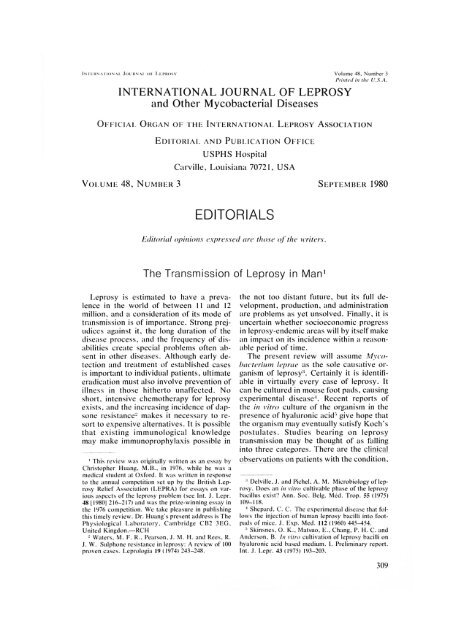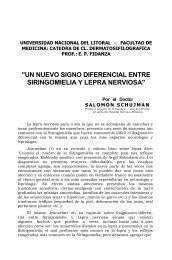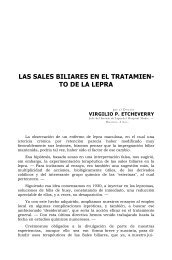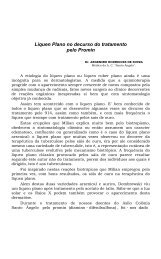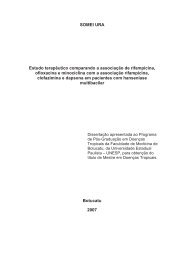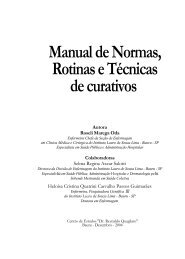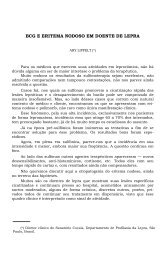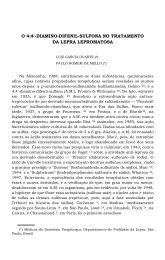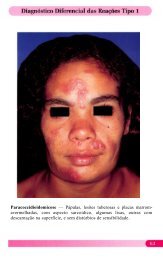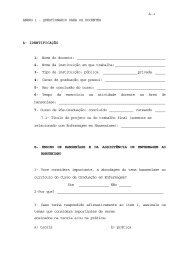EDITORIALS - Index of
EDITORIALS - Index of
EDITORIALS - Index of
You also want an ePaper? Increase the reach of your titles
YUMPU automatically turns print PDFs into web optimized ePapers that Google loves.
IN Ira RNA I ION \ I JOURNI \ i ()I 1.11.1tosl -^Volume 48, Number 3<br />
INTERNATIONAL JOURNAL OF LEPROSY<br />
and Other Mycobacterial Diseases<br />
i'rinted in the<br />
OFFICIA I ORGAN OF THE INTERNATIONAL LEPROSY ASSOCIATION<br />
EDITORIAL. AND PUI3LICATION OFFICE<br />
USPHS Hospital<br />
Carville, Louisiana 70721, USA<br />
Voi.umi: 48, NUMBER 3^ SEPTEMBER 1980<br />
<strong>EDITORIALS</strong><br />
Editorial opinions e.spres.s .ed are tho.se^the writers.<br />
The Transmission <strong>of</strong> Leprosy in Man'<br />
Leprosy is estimated to have a prevalence<br />
in the world <strong>of</strong> between 11 and 12<br />
million, and a consideration <strong>of</strong> its mode <strong>of</strong><br />
transmission is <strong>of</strong> importance. Strong prejudices<br />
against it, the long duration <strong>of</strong> the<br />
disease process, and the frequency <strong>of</strong> disabilities<br />
create special problems <strong>of</strong>ten absent<br />
in other diseases. Although early detection<br />
and treatment <strong>of</strong> established cases<br />
is important to individual patients, ultimate<br />
eradication must also involve prevention <strong>of</strong><br />
illness in those hitherto unaffected. No<br />
short, intensive chemotherapy for leprosy<br />
exists, and the increasing incidence <strong>of</strong> dapsone<br />
resistance" makes it necessary to resort<br />
to expensive alternatives. It is possible<br />
that existing immunological knowledge<br />
may make immunoprophylaxis possible in<br />
' This review was originally written as an essay by<br />
Christopher Huang, M.B., in 1976. while he was a<br />
medical student at Oxford. It was written in response<br />
to the annual competition set up by the British leprosy<br />
Relief Association (LEPRA1 for essays on various<br />
aspects <strong>of</strong> the leprosy problem (see Int. J. Lepr.<br />
48 119801 216-2171 and was the prize-winning essay in<br />
the 1976 competition. We take pleasure in publishing<br />
this timely review. Dr. Huang's present address is The<br />
Physiological Laboratory. Cambridge C132 3EG,<br />
United Kingdon.—RCH<br />
Waters. M. F. R.. Pearson. J. M. H. and Rees. R.<br />
J. W. Sulphone resistance in leprosy: A review <strong>of</strong> 100<br />
proven cases. Leprologia 19 119741 243-248.<br />
the not too distant future, but its full development,<br />
production, and administration<br />
are problems as yet unsolved. Finally, it is<br />
uncertain whether socioeconomic progress<br />
in leprosy-endemic areas will by itself make<br />
an impact on its incidence within a reasonable<br />
period <strong>of</strong> time.<br />
The present review will assume Mycobacterium<br />
/eprae as the sole causative organism<br />
<strong>of</strong> leprosy`. Certainly it is identifiable<br />
in virtually every case <strong>of</strong> leprosy. It<br />
can be cultured in mouse foot pads, causing<br />
experimental disease ' . Recent reports <strong>of</strong><br />
the in vitro culture <strong>of</strong> the organism in the<br />
presence <strong>of</strong> hyaluronic acid.' give hope that<br />
the organism may eventually satisfy Koch's<br />
postulates. Studies hearing on leprosy<br />
transmission may be thought <strong>of</strong> as falling<br />
into three categores. There are the clinical_<br />
observations on patients with the condition,<br />
Delville, J. and Pichel. A. NI. Microbiology <strong>of</strong> leprosy.<br />
Does an in vitro cultivable phase <strong>of</strong> the leprosy<br />
bacillus exist? Ann. Soc. Belg. Med. Trop. 55 11975)<br />
109-118.<br />
' Shepard. C. C. The experimental disease that follows<br />
the injection <strong>of</strong> human leprosy bacilli into footpads<br />
<strong>of</strong> mice. J. Exp. Med. 112 119601 445-454.<br />
' Skinsnes, 0. K., Matsuo, E., Chang, P. H. C. and<br />
Anderson, B. In vitro cultivation <strong>of</strong> leprosy bacilli on<br />
hyaluronic acid based medium. I. Preliminary report.<br />
Int. J. Lepr. 43 )1975) 193-203.<br />
309
310^ /uteri/at/ono/ .lournal <strong>of</strong> Leprosy^ 1980<br />
which form the bulk <strong>of</strong> the work as they are<br />
the easiest to do in the field. Studies have<br />
also been made <strong>of</strong> experimental systems,<br />
and, finally, there are epidemiological stud-<br />
ies to which a separate section is devoted in<br />
this account. The results <strong>of</strong> such work can<br />
be brought to bear on one or more <strong>of</strong> the<br />
following steps, here assumed component<br />
stages in the transmission process:<br />
a. The release <strong>of</strong> viable organisms from<br />
the host into the environment.<br />
b. The presence <strong>of</strong> viable organisms so<br />
released in the environment.<br />
c. Entry into the new human host and<br />
distribution within the body.<br />
d. Production <strong>of</strong> clinical illness.<br />
Any one <strong>of</strong> these factors could determine<br />
the apparent rate <strong>of</strong> transmission. Thus in<br />
the presence <strong>of</strong> very large numbers <strong>of</strong> organisms<br />
in the environment, the overall incidence<br />
could well become a function <strong>of</strong> the<br />
last step, making – constitutional – factors<br />
the main determinant <strong>of</strong> the appearance <strong>of</strong><br />
clinical illness.<br />
1) THE RELEASE OF VIABLE<br />
ORGANISMS FROM THE HOST<br />
INTO THE ENVIRONMENT<br />
a. Skin. It has been assumed until relatively<br />
recently that leprosy transmission is<br />
by prolonged skin-to-skin contact. This notion<br />
probably derived from the cutaneous<br />
clinical signs. Periaswami" found considerable<br />
numbers <strong>of</strong> acid-fast bacilli in intact<br />
skin <strong>of</strong> lepromatous patients. In 1976, Ridley,<br />
et a/. 7 found the fingers to be the skin<br />
site hearing the highest bacterial load.<br />
However, convincing evidence was not<br />
presented that M. leprae could cross intact<br />
epidermis. Such organisms as were found<br />
could well have come from portals <strong>of</strong> exit<br />
elsewhere. This assertion would predict the<br />
presence <strong>of</strong> bacilli on skin as an inconstant<br />
finding, and, indeed, Pedley" found very<br />
few leprosy bacilli on lepromatous patches<br />
" Periaswami, P. The distribution <strong>of</strong> Mycobacterium<br />
leprae in different structures <strong>of</strong> the skin. Lepr.<br />
India 41) (1968) 178-189.<br />
Ridley, NI., Jopling, W. H. and Ridley, D. S. Acid<br />
fast bacilli in the fingers <strong>of</strong> long-treated lepromatous<br />
patients. Lepr. Rev. 47 (1976) 93-96.<br />
Pedley, J. C. Summary <strong>of</strong> results <strong>of</strong> a search <strong>of</strong><br />
the skin surface for Mycobacterium leprae. Lepr.<br />
Rev. 41 (1970) 167-168.<br />
<strong>of</strong> skin, using a composite skin contact<br />
smear technique. However, where skin is<br />
breached, it may not he unreasonable to<br />
assume that a heavily infected underlying<br />
(fermis might enable leprosy bacilli to escape<br />
onto the surface and thus into the environment.<br />
One publication" has indicated<br />
that more than 20 million bacilli per day<br />
could have been shed into the environment<br />
from a patient with ulcerating lepromatous<br />
leprosy.<br />
h) Urogenital tract. Present evidence<br />
available attaches little importance to this<br />
route. Testes <strong>of</strong> mice, whether normal or<br />
immunologically deficient"', and the testes<br />
<strong>of</strong> males with lepromatous leprosy contain<br />
large numbers <strong>of</strong> organisms, but it has not<br />
been shown that they are present in significant<br />
numbers in semen. Bacilli are rarely<br />
found in glomeruli or renal tubular cells.<br />
Their occurrence in urine has not been convincingly<br />
demonstrated.<br />
c) Mammary glands. The milk <strong>of</strong> lactating<br />
mothers contains large numbers <strong>of</strong> M.<br />
leprae, Pedley" having found 118 bacilli in<br />
one drop spread over a slide. Although neither<br />
this nor other publications have counted<br />
bacilli in a series <strong>of</strong> such patients, the<br />
above observation, taken with the finding<br />
<strong>of</strong> large numbers <strong>of</strong> bacilli in the lumen <strong>of</strong><br />
the lactiferous duct', suggests that a child<br />
drinking one pint <strong>of</strong> breast milk daily might<br />
well ingest—<strong>of</strong>ten over a period <strong>of</strong> years—<br />
significant numbers <strong>of</strong> bacilli. The importance<br />
<strong>of</strong> this route in the spread <strong>of</strong> leprosy<br />
is, however, far from clear: pharyngeal or<br />
intestinal lesions analogous to those in tuberculosis<br />
are not known to occur in leprosy,<br />
and index cases in families are very<br />
frequently not the mother.<br />
d) Upper respiratory tract. In the developed<br />
case, ulcerating lepromatous granulation<br />
tissue may occur in the s<strong>of</strong>t palate,<br />
uvula, and nasopharynx. Conceivably,<br />
" McDougall, A. C. and Rees, R. J. W. Ulcerating<br />
lepromatous leprosy in a patient with dapsone-resistant<br />
Mycobacterium leprae. Lepr. Rev. 44 (1973) 59-<br />
64.<br />
'" Rees, R. J. W., McDougall, A. C. and Weddell,<br />
A. G. M. The testis in mice infected with .Ifycobacteriniti<br />
leprae. J. Pathol. 115 (1975) 73-79.<br />
" Pedley, J. C. The presence <strong>of</strong> .11. leprae in human<br />
milk. Lepr. Rev. 38 (1967) 239-242.<br />
12 Pedley, J. C. The presence <strong>of</strong> .1f. leprae in the<br />
lumina <strong>of</strong> the female mammary gland. Lepr. Rev. 39<br />
(1968) 201-202.
48, 3 Editorials<br />
311<br />
Fiu. 1. At an original magnification <strong>of</strong> x 1000 and<br />
in an area occupying approximately one-third <strong>of</strong> an oil<br />
immersion field, leprosy bacilli are seen: a) singly, b)<br />
in groups <strong>of</strong> various sizes, and c) in large glohi. Nasal<br />
smear from a patient with untreated lepromatous lep-<br />
rosy in Nepal (Dr. J. C. Pedley, Tansen, Nepal), Ziehl-<br />
Neelsen stain. Leitz Orthomat microscope. Kodak<br />
2483 photomicrography film.<br />
these might release bacilli, but more remarkable<br />
is the early nasal involvement in<br />
lepromatous leprosy, first noticed in the<br />
1890s. Rogers and Muir" suggested that<br />
viable bacilli could occur in clinically important<br />
numbers in nasal discharge, even in<br />
the absence <strong>of</strong> florid clinical features, especially<br />
during coughing or sneezing (Fig.<br />
I). Recent work confirms this theory for<br />
lepromatous and near-lepromatous leprosy.<br />
Thus:<br />
I) Nasal involvement is clinically apparent<br />
at an early stage in lepromatous leprosy''.<br />
2) Nasal infection is bacteriologically de-<br />
'" Rogers, L. and Muir, E. Leprosy. 3rd ed. Bristol:<br />
John Wright & Sons Ltd., 1946, p. 152.<br />
" Barton, R. P. E. A clinical study <strong>of</strong> the nose in<br />
lepromatous leprosy. Lepr. Rev. 45 (1974) 135-144.<br />
Fie. 2. Droplet dispersal following a violent<br />
sneeze. (From Jennison, M. W. Atomizing <strong>of</strong> mouth<br />
and nose secretions into the air by high-speed photog-<br />
raphy. In: crobio/ogy. Foust, R. M., ed. Washing-<br />
ton: American Association for the Advancement <strong>of</strong><br />
Science, No. 17, 1942, p. 102. Up to 20,000 droplets<br />
are produced in a stream, mostly from the mouth, but<br />
larger masses <strong>of</strong> material ("streamers — ) as well as<br />
droplets are expelled from the nose when there is ex-<br />
cess nasal excretion. Reproduced with permission<br />
from Mims, C. A. The Pathogenesis <strong>of</strong> IntectionN /EN-<br />
ease. London: Academic Press, 1977, p. 29.<br />
monstrable especially in the middle and inferior<br />
turbinates and more marked than in<br />
skin in early lepromatous leprosy".<br />
3) Highly bacilliferous nasal discharges<br />
occur in cases <strong>of</strong> untreated lepromatous<br />
leprosy. This was clear from nasal mucous<br />
smears from such cases, which showed<br />
high bacterial and morphological indices<br />
clearly exceeding those obtained from skin.<br />
Similar results have been obtained from<br />
studies <strong>of</strong> nasal discharges (Fig. I). Mouse<br />
foot pad studies confirmed that the organisms<br />
were M. /eprae'".<br />
4) Large numbers <strong>of</strong> leprosy bacilli are<br />
projected from the upper respiratory tract<br />
for distances <strong>of</strong> up to 30 to 50 cm during<br />
sneezing and coue,hing' 7 . This is consistent<br />
with the aerosol effect <strong>of</strong> a sneeze (Fig. 2),<br />
which would clearly provide an efficient<br />
route <strong>of</strong> exit for bacilli. It is possible that<br />
" Davey, T. F. and Barton, R. P. E. Multiple nasal<br />
smears in early lepromatous leprosy. Lepr. Rev. 45<br />
(1974) 158-165.<br />
'" Davey. F. and Rees, R. J. W. The nasal discharge<br />
in leprosy: Clinical and bacteriological aspects.<br />
Lepr. Rev. 45 (1974) 121-134.<br />
Pedley, J. C. and Geater, J. G. Does droplet infection<br />
play a role in the transmission <strong>of</strong> leprosy?<br />
Lepr. Rev. 47 (1976) 97-102.
312^ International Journal <strong>of</strong> Leprosy^ 1980<br />
some organisms may even be released during<br />
normal breathing'".<br />
5) Leprosy bacilli may persist in the<br />
nose, as evidenced from scrapings and<br />
biopsies <strong>of</strong> nasal mucosa, even after clinical<br />
improvement following prolonged dapsone<br />
therapy'''. However, in these cases the histological<br />
integrity <strong>of</strong> the overlying epithelium<br />
was restored. Most organisms seen<br />
were fragmented'". Furthermore, Pedley"'<br />
found that morphologically normal bacilli<br />
were absent from nosehlows after six<br />
months <strong>of</strong> dapsone treatment. Therefore,<br />
nasal release <strong>of</strong> bacilli is probably <strong>of</strong> importance<br />
primarily in active untreated lepromatous<br />
leprosy.<br />
Experimental results concur with the<br />
clinical findings. Normal and immunologically<br />
deficient mice were inoculated with<br />
M. /eprae locally in the foot pad and ear<br />
and intravenously and intraperitoneally.<br />
Subsequent quantitative bacteriological assessments<br />
revealed a large percentage <strong>of</strong><br />
animals with more than 5 x 14' bacilli in<br />
the uninoculated car, foot pads, or nose;<br />
the nose was the most frequently and heavily<br />
infected. Here bacilli were histologically<br />
demonstrable in nasal ciliated epithelial<br />
cells from which they might conceivably he<br />
released. In contrast, bacilli were rare in<br />
the squamous epithelium <strong>of</strong> the skin, even<br />
when the underlying dermis was heavily infected'''.<br />
Similar results have been obtained<br />
from studies <strong>of</strong> the armadillo.<br />
Discussion. If M. leprae and M. tuberculosis<br />
. are phylogenetically related organisms,<br />
then it is not entirely unreasonable to<br />
conceive <strong>of</strong> their having parallel routes <strong>of</strong><br />
exit from their human hosts. Evidence at<br />
'" Bedi, B. M., Narayanan, E., Streevatsa, M., Kirchheimer,<br />
W. F. and Balasubrahmanyam, M. Dispersal<br />
<strong>of</strong> Mycobacterium leprae by leprosy patients<br />
while breathing. Ann. Indian Acad. Med. Sci. 12<br />
(1976) 1-15.<br />
'" Barton, R. P. E. and Hogerzeil, L. M. Lepromatous<br />
leprosy in the nose after one year <strong>of</strong> dapsone<br />
treatment. Clinical and bacteriological findings. Lepr.<br />
Rev. 46 (1975) 257-265.<br />
2" McDougall, A. C., Rees, R. J. W., Weddell, A.<br />
G. M. and Kanan, M. W. The histopathology <strong>of</strong> lepromatous<br />
leprosy in the nose. J. Pathol. 115 (1975)<br />
215-226.<br />
"' Pedley, J. C. The nasal mucous in leprosy. Lepr.<br />
Rev. 44 (1973) 33-35.<br />
" Rees, R. J. W., McDougall, A. C. and Weddell,<br />
A. G. M. The nose in mice with experimental human<br />
leprosy. Lepr. Rev. 45 (1974) 112-120.<br />
hand makes this possibility increasingly attractive.<br />
The importance <strong>of</strong> a discharge <strong>of</strong><br />
millions <strong>of</strong> leprosy bacilli from the nasal<br />
tract, indicated by the evidence cited above,<br />
cannot he discounted easily. The analogy<br />
persists also in quantitative terms. Comparison<br />
between outputs <strong>of</strong> leprosy bacilli<br />
from 24 hr noseblow collections and tuberculosis<br />
bacilli from 24 hr sputum collections<br />
gave pathogen yields <strong>of</strong> the same high order<br />
<strong>of</strong> magnitude (10") with respective standard<br />
deviations <strong>of</strong> only one order <strong>of</strong> magnitude'"`.<br />
However, the story is probably still incomplete.<br />
The evidence above implies that<br />
nasal discharge <strong>of</strong> organisms is not important<br />
in patients with tuberculoid and borderline<br />
leprosy. Yet in the presulfone era,<br />
the risk <strong>of</strong> acquiring leprosy from household<br />
contact with a case <strong>of</strong> lepromatous<br />
leprosy was eight times the risk where<br />
there was no such contact, but it was still<br />
four times the risk where the contact was<br />
with a case <strong>of</strong> tuberculoid leprosy. These<br />
risks are within one order <strong>of</strong> magnitude.<br />
Thus transmission <strong>of</strong> leprosy to household<br />
members cannot he solely dependent on the<br />
number <strong>of</strong> organisms released from cases<br />
within the household. This number <strong>of</strong> organisms<br />
is enormous in lepromatous leprosy<br />
and low or absent in tuberculoid and<br />
many borderline cases.<br />
2) THE PRESENCE OF VIABLE<br />
ORGANISMS SO RELEASED IN<br />
THE ENVIRONMENT<br />
Having been released from the patient in<br />
significant numbers and in viable form, the<br />
organism must be dispersed sufficiently to<br />
explain the widespread occurrence <strong>of</strong> the<br />
disease. At the same time, there must he a<br />
sufficient concentration <strong>of</strong> organisms to infect<br />
an individual. Several possible mechanisms<br />
<strong>of</strong> dispersal must be considered.<br />
a. Dust and droplets. Transmission <strong>of</strong> tuberculosis<br />
via this route owes much to the<br />
viability <strong>of</strong> the causative organisms in desiccated<br />
sputum. Studies <strong>of</strong> the viability <strong>of</strong><br />
desiccated leprosy bacilli using the mouse<br />
foot pad technique revealed full survival<br />
after 24 hr but only 10% survival after 1.75<br />
days"<br />
2" Meade, 'F. W. Growing points in leprosy research.<br />
2. Epidemiology. Lepr. Rev. 45 11974) 15-21.
48, 3 ^ Editorials ^ 313<br />
b. Arthropods that feed on blood. Untreated<br />
borderline or lepromatous leprosy<br />
patients have an acid-fast bacillemia <strong>of</strong> 5000<br />
to 500,000 viable bacilli per m1 1 '. Nevertheless,<br />
the possible resulting transfer <strong>of</strong><br />
pathogens via the blood feed <strong>of</strong> an arthropod<br />
remains quantitatively small compared<br />
to the number <strong>of</strong> organisms released by the<br />
nasal route. Homogenates <strong>of</strong> laboratory<br />
bred mosquitoes (C/r/ex fiiti,i,q/oN) and bedbugs<br />
(Cimex hemipteras) previously allowed<br />
to feed freely on lepromatous leprosy<br />
patients <strong>of</strong>ten contained leprosy<br />
bacilli, as confirmed by mouse foot pad<br />
studies. Some remained viable up to 48 hr<br />
after the blood meal. But the number <strong>of</strong><br />
bacilli in both instances was small''. Furthermore,<br />
the frequency with which acidfast<br />
bacilli occurred in homogenates <strong>of</strong> such<br />
arthropods from homes with an open lepromatous<br />
case did not differ from those <strong>of</strong><br />
random collections. In both, the frequency<br />
was small .'").<br />
c. Diptera. Studies have been made on<br />
the housefly (Alusca), the bluebottle (Calliphora),<br />
and the biting stable fly (Stomoxys).<br />
These were allowed to feed on lepromatous<br />
nasal secretions or ulcerated skin<br />
lesions. Pooled homogenates <strong>of</strong> legs,<br />
mouthpieces, abdominal wall, and stomach<br />
were all heavily infected one hr after feeding.<br />
A small proportion had diminishing<br />
numbers <strong>of</strong> bacilli up to three days later.<br />
The flies showed a predilection for nasal<br />
secretions and were demonstrated to be capable<br />
<strong>of</strong> infecting surfaces upon which they<br />
subsequently fed 2". Further work will he<br />
necessary to assess the extent to which flies<br />
may thus contribute to the level <strong>of</strong> environmental<br />
infection. In some parts <strong>of</strong> the world<br />
(Fig. 3) they might play a significant role in<br />
at least the mechanical transport <strong>of</strong> pathogenic<br />
organisms, including M. leprac.<br />
d) Other possible environmental sources.<br />
Large numbers <strong>of</strong> acid-fast bacilli not culturable<br />
on standard mycobacterial media<br />
2 ' Shankara Manja, K. Demonstration <strong>of</strong> Mycobacterium<br />
leproe and its viability in the peripheral blood<br />
<strong>of</strong> leprosy patients. Lepr. Rev. 43 (1972) 181-187.<br />
2" Narayanan, E., Manja, K. S. and Kirchhcimer,<br />
W. F. Occurrence <strong>of</strong> Mycobacterium leprue in arthropods.<br />
Lepr. Rev. 43 (1972) 194-198.<br />
Geater, J. G. The fly as a potential vector in the<br />
transmission <strong>of</strong> leprosy. Lepr. Rev. 46 (1975) 279-286.<br />
FIG. 3. " '.11u.s . ca Norben.■ is completely ignored by<br />
the Masai, but is the principal vector <strong>of</strong> certain eye<br />
disease infections.• Reproduced with permission from<br />
Insects and Other Arthropods <strong>of</strong> .1/edica/ importance.<br />
Smith, K. V. 0., ed. London: 'Trustees <strong>of</strong> the British<br />
Museum (Natural History), 1973.<br />
were found in skin lesions, nerve, lymph<br />
nodes, skin, and liver <strong>of</strong> seven armadillos<br />
captured from the wild (Walsh, G. P., et<br />
al. personal communication, 1976). This<br />
could reflect indigenous infection in such<br />
animals, suggesting a non-human source <strong>of</strong><br />
leprosy bacilli. However, definite conclusions<br />
concerning leprosy bacilli originating<br />
from or lodging in animals are probably premature.<br />
Finally, there is anecdotal evidence<br />
that leprosy bacilli may be harbored<br />
in plants"•". (See also the recent work <strong>of</strong><br />
Kazda, et al. Int. J. Lepr. 48 [19801 1-6,<br />
who report noncultivable acid-fast bacilli<br />
in sphagnum and moss vegetation from the<br />
former leprosy endemic areas <strong>of</strong> Norway<br />
and that these bacilli multiply like Al. Leprae<br />
in mouse foot pads.—RCH)<br />
Discussion. There is a lack <strong>of</strong> evidence<br />
bearing on this aspect <strong>of</strong> leprosy transmission.<br />
Various mechanisms such as dust,<br />
droplets, and flies could be involved, but<br />
their relative importance is unknown. Perhaps<br />
further insight may be gained by an<br />
epidemiological approach (see below).<br />
Barker, D. J. P., Clancey• J. K., Morrow, R. H.<br />
and Rao, S. Transmission <strong>of</strong> Buruli Disease. Brit.<br />
Med. J. 4 (1970) 558.<br />
" Temine, P. and Privat, Y. A case <strong>of</strong> leprosy apparently<br />
contracted in France. Ann. Med. Nancy 157<br />
(1973) 444-445.
314^ International Journal <strong>of</strong> Leprosy^ 1980<br />
3) THE ENTRY OF PATHOGENS INTO<br />
THE NEW HUMAN HOST AND<br />
DISTRIBUTION WI'l'IIIN THE BODY<br />
Possible sites <strong>of</strong> entry are considered<br />
first.<br />
a. Respiratory tract. In view <strong>of</strong> results<br />
cited earlier, the upper respiratory tract<br />
would seem a likely site for entry. However,<br />
tissue allowing entry <strong>of</strong> the pathogen<br />
need not he where the pathology occurs.<br />
Furthermore, bacilliferous particles lodging<br />
in the nose must he <strong>of</strong> rather larger size<br />
than those lodging in the lower respiratory<br />
tract. It is uncertain whether such larger<br />
particles would he the infective fraction <strong>of</strong><br />
the total inhaled bacillary load. The lower<br />
respiratory tract has been demonstrated to<br />
he an effective site <strong>of</strong> entry for M. tithercu-<br />
/osi.s.2"•". Conceivably, this could apply<br />
also to the leprosy bacillus. Both have similar<br />
viabilities in dust and droplets. They<br />
have similar attack rates in family or household<br />
contacts". The fact that the pathogens<br />
are <strong>of</strong>ten experimentally absent from the<br />
lung does not exclude its being a route <strong>of</strong><br />
entry since the pathogens would he expected<br />
to he carried elsewhere rapidly. It<br />
would be desirable to test this idea more<br />
directly, perhaps by giving measured numbers<br />
<strong>of</strong> bacilli in a known dispersion via a<br />
tracheostomy to experimental animals and<br />
assessing for subsequent infection: 32 .<br />
h. Gastrointestinal tract. Possibly (as<br />
noted above with tuberculosis), gut entry<br />
<strong>of</strong> pathogens might occur with children<br />
breast fed by infected mothers. It is not<br />
known whether food or drink, including<br />
that contaminated by flies, are likely vehicles.<br />
c. Skin. Classically this has been regarded<br />
as the most likely entry point. However,<br />
in view <strong>of</strong> the nature <strong>of</strong> cornified epithelium,<br />
it seems unlikely in the absence <strong>of</strong><br />
2" Wells, J. On the mechanics <strong>of</strong> droplet nuclei infection:<br />
apparatus for quantitative study <strong>of</strong> droplet<br />
nuclei infection <strong>of</strong> animals. Am. J. Hyg. 47 (1948) I-<br />
10.<br />
" Lurie, M. B. Native and acquired resistance to<br />
tuberculosis. Am. J. Med. 9 (1950) 591-610.<br />
"' Rees, R. J. W. and Meade, T. W. Comparison <strong>of</strong><br />
the modes <strong>of</strong> spread and the incidence <strong>of</strong> tuberculosis<br />
and leprosy. Lancet 1 (1974) 47-49.<br />
" Rees, R. J. W. and McDougall, A. C. Airborne<br />
infection with Mycobacterium leprae in mice. J. Med.<br />
Microbiol. 10 (1977) 63-68.<br />
contrary evidence that leprosy bacilli penetrate<br />
intact skin. Only anecdotal evidence<br />
exists for pathogen entry via breaks in<br />
skin:" 1 ; such findings could reflect an early<br />
manifestation <strong>of</strong> previous infection occurring<br />
at a site <strong>of</strong> skin trauma. Indeed, attempts<br />
to transmit leprosy to human volunteers<br />
via the cutaneous route have been<br />
largely unsuccessful. Finally, it is quite<br />
possible (see below) that lesions in the skin<br />
and peripheral nerve could reflect pathogens<br />
reaching such sites via the blood<br />
stream rather than by local skin entry.<br />
Transport <strong>of</strong> organisms from their site <strong>of</strong><br />
entry. Blood carriage <strong>of</strong> M. /eprac certainly<br />
occurs. Thus visceral lesions are seen<br />
postmortem in all clinical forms, <strong>of</strong>ten in<br />
loci not explicable merely by lymphatic<br />
spread. Up to 10 5 viable leprosy bacilli per<br />
ml <strong>of</strong> blood are demonstrable in cases <strong>of</strong><br />
untreated lepromatous leprosy:" .a:'. Hence<br />
bacilli could well enter at a site remote from<br />
where they produce clinically evident pathology,<br />
provided that they have a predilection<br />
for these latter sites"'. Indeed, if local<br />
temperature participates in directing<br />
bacilli to particular sites: 37 •" 8 , the nasal and<br />
skin involvement is explicable without invoking<br />
them as sites <strong>of</strong> pathogen entry.<br />
4) THE PRODUCTION OF<br />
CLINICAL ILLNESS<br />
Factors hearing on whether infection actually<br />
leads to illness are relevant to interpretation<br />
<strong>of</strong> studies where the appearance<br />
<strong>of</strong> clinical disease is the index <strong>of</strong> transmission<br />
having occurred. In tuberculosis, ge-<br />
Nebout, F. Report <strong>of</strong> a case <strong>of</strong> nodular tuberculoid<br />
leprosy, localized, in an adult African male, on<br />
ritual scarification. Rep. Med. Trop. 33 (1973) 523-<br />
528.<br />
Drutz, D. J., Chen, T. S. N. and Wen Hsiang. L.<br />
The continuous bacteremia <strong>of</strong> lepromatous leprosy.<br />
New Engl. J. Med. 287 (1972) 159-164.<br />
Palma, M. N. and Desikan, K. V. Bacillaemia in<br />
leprosy. Indian J. Med. Res. 63 (1975) 888-892.<br />
" Weddell, A. G. M. and Palmer, E. The pathogenesis<br />
<strong>of</strong> leprosy. An experimental approach. Lepr.<br />
Rev. 34 (1963) 57-61.<br />
" 7 Sabin, 'F. D. Temperature-linked sensory loss: A<br />
unique pattern in leprosy. Arch. Neurol. 20 (1969)<br />
252-262.<br />
"" Sabin, T. D., Hackett, E. R. and Brand, P. W.<br />
Temperatures along the course <strong>of</strong> certain nerves <strong>of</strong>ten<br />
affected in lepromatous leprosy. Int. J. Lepr. 42 (1974)<br />
38-42.
48, 3^ Ed/to/lois^ 315<br />
notype", constitutional factors", and history<br />
<strong>of</strong> past exposure are important in this<br />
connection. Similar considerations might<br />
apply in leprosy. In the Netherlands, despite<br />
the significant increase in leprosy patients<br />
moving freely in a crowded community<br />
owing to immigration, only three<br />
autochthonous cases have been discovered"'.<br />
But leprosy may he rather more<br />
"infectious" than is reflected in its clinical<br />
incidence, and indeed lymphocyte transformation<br />
studies were negative in subjects<br />
new to an endemic area but <strong>of</strong>ten positive<br />
in those longer resident or who were leprosy<br />
contacts". Other immunological methods<br />
gave concordant results''.<br />
Some insight into this problem might<br />
come from immunological consideration <strong>of</strong><br />
the tuberculoid-lepromatous polarity''.<br />
I epromatous patients have several altered<br />
or suppressed indicators <strong>of</strong> immunological<br />
reactivity"• ". There is increasing agreement<br />
that this reflects a lack <strong>of</strong> T-cells able<br />
to initiate a response to M. l eprac antigens'"•<br />
Thus the specificity <strong>of</strong> the deficiency<br />
in the cell-mediated response to leprosy<br />
bacilli 17 places the lesion temporally<br />
after T-lymphocyte genesis. It is tempting<br />
to postulate that such a deficiency is also<br />
"" Palmer Carroll, E., Jablon, S. and Edwards, P.<br />
Tuberculosis morbidity <strong>of</strong> young men in relation to<br />
tuberculin sensitivity and body build. Am. Rev. Tuberc.<br />
76 (1957) 517-539.<br />
"' Leiker, D. L. Leprosy in the Netherlands. Int.<br />
J. Lepr. 45 (1977) 195-196.<br />
•" Godal, T. and Negassi, K. Subclinical infection<br />
in leprosy. Brit. Med. J. 3 (1973) 557-559.<br />
Myrvang, B. Immune responses to Mycobacterium<br />
leprue. J. Oslo City Hosp. 25 (1975) 3-24.<br />
1" Lowe, J. The leprosy bacillus and the host reaction<br />
to it. In: Experimetal Tuberculosis with an Addendum<br />
on Lepro.s .y. Ciba Foundation Symposium.<br />
London: J. & A. Churchill, 1955, 344-354.<br />
" Godal, T., Myklestal, 13., Samuel, I). K. and Myryang,<br />
B. Characterization <strong>of</strong> the cellular immune defect<br />
in lepromatous leprosy: A specific lack <strong>of</strong> circulating<br />
Mycobacterium leprae reactive lymphocytes.<br />
Clin. Exp. Immunol. 9 (1971) 821-831.<br />
Skinsnes, 0. K. The lepromatous macrophage<br />
defect as related to vaccine development in leprosy.<br />
Int. J. Lepr. 44 (1976) 485-490.<br />
Litn, S. D., Kiszkiss, D. F., Jacobson. P. R.,<br />
Choi, Y. S. and Good, R. A. Thymus dependent lymphocytes<br />
<strong>of</strong> peripheral blood in leprosy patients. Infect.<br />
lmmun. 9 (1974) 349-399.<br />
Job, C. K., Chacko, C. J. G., Taylor, P. NI., Daniel,<br />
NI. and Jesudian, G. Evaluation <strong>of</strong> cell-mediated<br />
immunity in the histopathologic spectrum <strong>of</strong> leprosy<br />
using the lymphocyte transformation test. Int. J. Lepr.<br />
44 (1976) 256-264.<br />
present in non-lepromatous leprosy, albeit<br />
to a different degree -18 • 1". Hastings" considers<br />
several possible levels for such deficiencies:<br />
a. The initial inoculum. It is possible that<br />
size, route, timing, or frequency <strong>of</strong> infection<br />
is important. In mice, past exposure<br />
could affect how much pathogen is needed<br />
to cause illness'''. More than one leprosy<br />
bacillus strain with different virulences is<br />
conceivable.<br />
b. 'I'-lymphocyte activation mechanisms.<br />
These are antigen-specific and so could he<br />
sites for the defect. Possible mechanisms<br />
include a functional defect <strong>of</strong> specifically<br />
sensitized "helper" T-cells or excess "suppressor"<br />
T-cells in the heterogeneous population.<br />
Alternatively, there may be involvmem<br />
<strong>of</strong> antigen-specific humoral factors<br />
involved in controlling cell-mediated immunity""<br />
2 . It is emphasized that such considerations<br />
are speculative.<br />
c. Enzyme deficiencies. A genetic metabolic<br />
defect in II-elucuronidase has been<br />
suggested for lepromatous leprosy". The<br />
resulting elevated macrophage hyaluronic<br />
acid might then he a nutritional substrate<br />
for leprosy bacilli:':'. .... . 56 .<br />
Godat, T., L<strong>of</strong>gren. NI. and Negassi, K. Immune<br />
response to Mycobacterium /eprae <strong>of</strong> healthy leprosy<br />
contacts. Int. J. Lepr. 40 (1972) 243-250.<br />
" Bullock. W. E. and Fasal. P. Studies <strong>of</strong> the immune<br />
response in leprosy. III. The role <strong>of</strong> cellular and<br />
Immoral factors in impairment <strong>of</strong> the in vitro immune<br />
response. J. Immunol. 106 (1971) 888-899.<br />
"" Hastings, R. C. Transfer factor as a probe <strong>of</strong> the<br />
immune defect in lepromatous leprosy. Int. J. Lepr.<br />
45 (1977) 281-291.<br />
" Levy, L. Superinfection in mice previously infected<br />
with Mycobacterium leprae. Infect. Immun. II<br />
(1975) 1094-1099.<br />
Wasal, P. H., Goralnick, S. and Bullock, W. E.<br />
Defective leukotaxis in patients with lepromatous leprosy.<br />
Int. J. Lepr. 44 (1976) 243-249.<br />
5" Skinsnes. 0. K. and Matsuo, E. Acid mucopoly-<br />
Saccharrde metabolism in leprosy. I. Storage <strong>of</strong> hyaluronic<br />
acid and its possible significance in the pathogenesis<br />
<strong>of</strong> leprosy. Int. J. Lepr. 42 (1974) 392-398.<br />
" Matsu°. E. and Skinsnes, O. K. ,Acid mucopolysaccharide<br />
metabolism in leprosy. 2. Sutec1lular localization<br />
<strong>of</strong> hyaluronic acid and 13-glucuronidase in<br />
leprous infiltrates suggestive <strong>of</strong> a host-Mycobacterium<br />
leprae metabolic relationship. Int. J. Lepr. 42 (1974)<br />
399-411.<br />
" Drutz, D. J. and Bodel. P. Mechanisms <strong>of</strong> endogenous<br />
pyrogen production in patients with leprosy:<br />
Why are patients with uncomplicated lepromatous leprosy<br />
()febrile? Int. J. Lepr. 42 (1974) 369.<br />
Garcia-Gonzalez, J. E., Rojas-Espinosa, 0. and<br />
Estrada-Parra, 0. Phagocytosis in leprosy I. The
316^ international .10arnal^Lepro.sy^ 1980<br />
(1. An underlying genetic involvement.<br />
Monozygotic and dizygotic twin pair studies<br />
display a definite genetic variation in<br />
susceptibility to clinical illness and the type<br />
<strong>of</strong> leprosy appearing''. There is familial<br />
clustering <strong>of</strong> leprosy patients and striking<br />
differences among different populations living<br />
in similar areas with respect to prevalence<br />
and type. Furthermore, the immune<br />
defect in lepromatous leprosy may exist<br />
before exposure to the pathogen'''. Therefore<br />
it may be useful to examine the genes<br />
known to affect the immune response. In<br />
mice, such Ir genes are closely linked to<br />
those encoding the classical transplant antigens<br />
on the I-12 complex <strong>of</strong> chromosome<br />
17 5"'". In man, the HLA complex probably<br />
also contains such an Ir area. The HLA<br />
antigens can therefore act as markers for<br />
the Ir system, provided that this genetic<br />
disequilibrium is consistently maintained"'•<br />
"2. ".<br />
Thorshy, et al."' found an increased frequency<br />
<strong>of</strong> HLA-BW1 in leprosy patients.<br />
Smith, et a/." 5 considered a possible association<br />
<strong>of</strong> HLA-A10 with leprosy. Dasgup-<br />
levels <strong>of</strong> "Diaphorase, — beta-glucuronidase, acid<br />
phosphatase, and lipase in circulating leukocytes.<br />
Lepr. Rev. 48 (1977) 17-26.<br />
Chakravarti, M. R. and Vogel, F. A twin study<br />
<strong>of</strong> leprosy. In: Topics . in Human Genetics. Vol. I.<br />
Becker, P. E., Lenz, W.. Vogel, F. and Wendt, G.,<br />
eds. Stuttgart: Georg Thieme Verlag, 1973, ix—I24.<br />
'" Dharmendra and Chatterjee, S. N. Prognostic<br />
value <strong>of</strong> the lepromin test in contacts <strong>of</strong> leprosy series.<br />
Lepr. India 27 11955) 149-158.<br />
'" I3ennacerraf, B. and Katz, I). H. The nature and<br />
function <strong>of</strong> histocompatihility-linked immune response<br />
genes. In: Immunogenetics and Immunodeficiency.<br />
Bennacerraf, B., ed. Baltimore: University Park<br />
Press, 1975. 117-177.<br />
"' Ivanyi, P. Some aspects <strong>of</strong> the H2 system, the<br />
major histocompatihility system in the mouse. Proc.<br />
R. Soc. Lond. 11202 (1978) 117-158.<br />
"' McDevitt, H. 0. and Bodmer, W. F. HL-A, immune-response<br />
genes and disease. Lancet 1 (1974)<br />
1269-1274.<br />
Bodmer, W. F., Jones, E. A., Barnstable, C. J.<br />
and Bodmer, J. G. Genetics <strong>of</strong> HLA: The major human<br />
histocompatihility system. Proc. R. Soc. Fond.<br />
8202 (1978) 93-116.<br />
"" Harris. R. I-ILA antigens and disease susceptibility.<br />
Medicine 2 (1978) 92-98.<br />
Thorsby, E., Godal, T. and Myrvang, B. HLA<br />
antigen and susceptibility to diseases. II. Leprosy.<br />
Tissue Antigens 3 (1973) 373-377.<br />
''' Smith, G. S., Walford, R. L., Shepard, C. C.,<br />
Payne, R. and Prochazka, G. J. Histocompatihility<br />
antigens in leprosy. Vox. Sang. 28 (1975) 42-49.<br />
ta, et al." found a marginal increase in<br />
HLA-138 and decrease in MLA-A9 frequencies.<br />
Nakajima, et al."' found no FILA differences<br />
between tuberculoid and lepromatous<br />
patients. Both groups had decreased<br />
HLA-AW24 and increased 1-ILA-<br />
AW29, HLA-A9, and HLA-138 frequencies.<br />
The last two are normally rare in the<br />
Japanese population studied. It therefore<br />
emerges that HLA studies in whole populations<br />
give contradictory results. However,<br />
this could reflect differences in genetic<br />
disequilibrium between Ir-type and<br />
HLA loci in different populations. Thus, de<br />
Vries, et al." studied nonrandom segregation<br />
among sibs within families in relation<br />
to host response. Sibs with the same type<br />
<strong>of</strong> leprosy showed a significant excess <strong>of</strong><br />
identical HLA haplotypes. This also applied<br />
in families where only tuberculoid leprosy<br />
occurred. Sibs with different types <strong>of</strong><br />
leprosy shared a haplotype less <strong>of</strong>ten than<br />
expected. These results suggest dominant<br />
genes predisposing to different types <strong>of</strong> leprosy<br />
linked to the HLA system. Most simply,<br />
two such gene sets may operate. Other<br />
factors being equal, the presence <strong>of</strong> say,<br />
gene "t — would permit tuberculoid leprosy<br />
to follow infection. The presence <strong>of</strong> gene<br />
"I — might permit lepromatous leprosy and<br />
the presence <strong>of</strong> both, borderline leprosy.<br />
The absence <strong>of</strong> both might confer effective<br />
immunity without disease. Certainly this<br />
scheme is an oversimplification, but it merits<br />
testing.<br />
Besides the HLA markers, there are the<br />
genes coding for the la-like 13-lymphocyte<br />
markers. In mice, the genes encoding Ia<br />
antigens reside in the Ir region <strong>of</strong> the H2<br />
complex"•". In man, the analogous area<br />
"' Dasgupta, A., Mehra, N. K.. Ghei, S. K. and<br />
Vaidya, NI. C. Histocompatihility antigens in leprosy.<br />
Tissue Antigens 5 (1975) 85-87.<br />
"' Nakajima, S., Nobayashi, S., Nohara, M. and<br />
Sato, S. HLA antigen and susceptibility to leprosy.<br />
Int. J. Lepr. 45 (1977) 273-277.<br />
de Vries, R. R. P., Lai A. Fat, R. F. M., Nijerhaus,<br />
L. E. and Van Rood. J. J. HLA-linked genetic<br />
control <strong>of</strong> host responses to Mycobacterium leprae.<br />
Lancet 2 (1976) 1328-1330.<br />
"" Freed, J. H., Brown, J. C. and Matherson. S. G.<br />
Studies on the carbohydrate structure <strong>of</strong> Ia alloantigens:<br />
Comparison with H-2K and H-2D gene products.<br />
In: Membrane Receptors Qf Lymphocytes. Seligman,<br />
NI., Preud'Homme, J. L. and Komilisky, F.<br />
NI., eds. Amsterdam: North Holland Publishing Co..<br />
1975, pp. 241-246.
48, 3^ Editorials^ 317<br />
probably resides on the HLA complex"".<br />
Studies <strong>of</strong> such markers might better reflect<br />
an association between Ir gene loci and disease<br />
susceptibility than the classical FILA<br />
antigens when testing the hypothesis that<br />
susceptibility to leprosy and the severity <strong>of</strong><br />
the resulting illness reflect a failure <strong>of</strong> Ir<br />
genes to code for an effective T-Iymphocyte<br />
response.<br />
It seems likely that the appearance <strong>of</strong><br />
clinical illness is a poor index <strong>of</strong> disease<br />
transmission since it is as much a function<br />
<strong>of</strong> host immune factors as it is <strong>of</strong> transmission<br />
factors. Therefore, separation <strong>of</strong> the<br />
host factors is important in assessing evidence<br />
bearing on transmission. Unfortunately,<br />
this must probably await further<br />
clarification <strong>of</strong> the mechanisms underlying<br />
the immune response.<br />
THE NEED FOR MORE<br />
E PIDEMIOLOGICAL STUDY<br />
Most <strong>of</strong> the studies described above examine<br />
only one parameter whose importance<br />
to the overall scheme <strong>of</strong> transmission<br />
is uncertain. This is not to decry these studies,<br />
which have succeeded in outlining<br />
some <strong>of</strong> the mechanisms <strong>of</strong> leprosy transmission.<br />
But further work attempting to<br />
clarify the relative importance <strong>of</strong> the component<br />
events must rely increasingly on epidemiological<br />
methods. If such methods enable<br />
a precise listing <strong>of</strong> high risk groups in<br />
quantitative terms, it should be possible, in<br />
principle, to construct and act on mathematical<br />
models <strong>of</strong> the overall process. Unfortunately,<br />
immense difficulties confront<br />
the execution <strong>of</strong> such studies, some reflecting<br />
the lack <strong>of</strong> epidemiological and recording<br />
facilities in areas where leprosy is endemic.<br />
There is also the difficulty <strong>of</strong> early<br />
diagnosis. The appearance <strong>of</strong> clinical illness<br />
is the final stage in a process <strong>of</strong> infection<br />
and its sequelae that may have been proceeding<br />
for many years, and this process is<br />
itself almost certainly influenced by a large<br />
number <strong>of</strong> environmental factors as yet<br />
poorly defined.<br />
A constructive epidemiological approach<br />
might include the following:<br />
Rachelefsky, G.. Park, M. S., Siegel, S., Terasaki,<br />
P. 1., Katz, R. and Saito, S. Strong association<br />
between 13-lymphocytes group-2 specificity and asthma.<br />
Lancet 2 (197.5) 1042-1044.<br />
a. Case-control studies. These can be<br />
done quickly and at relatively low cost on<br />
a small study population, but the difficulty<br />
in proving that leprosy had not been contracted<br />
would make it difficult to match<br />
controls. Furthermore, such a study would<br />
be retrospective. It would entail tracing<br />
events happening to a patient in his distant<br />
past, <strong>of</strong>ten in areas with inadequate records.<br />
h. Cohort studies. Prospective cohort<br />
studies look more promising. They could<br />
study incidence rather than prevalence,<br />
which might better reflect those infective<br />
events leading to clinical illnessn. In view<br />
<strong>of</strong> the low incidence <strong>of</strong> leprosy, it would be<br />
necessary to include a large population,<br />
ideally one in which prophylactic measures<br />
have yet to be introduced. The population<br />
should be a static one to assist tracing and<br />
follow-up. Case-finding and detection should<br />
be rigorously standardized. The results outlined<br />
in earlier sections might imply that,<br />
besides age, sex, and race, immunological<br />
status, genetic markers, familial, and past<br />
medical history should be monitored. Other<br />
variables worth including might be history<br />
<strong>of</strong> contacts, sanitation, overcrowding, and<br />
ways <strong>of</strong> disposing <strong>of</strong> nasal secretions-.<br />
c. Controlled clinical trials. These might<br />
examine whether a given factor, differing<br />
in two randomized groups, affects disease<br />
incidence. However, with knowledge in its<br />
present state, such an approach would<br />
seem premature.<br />
SUMMARY<br />
Existing clinical, scientific, and epidemiological<br />
knowledge on the mode <strong>of</strong> transmission<br />
<strong>of</strong> human leprosy is reviewed under<br />
the following headings:<br />
a. The release <strong>of</strong> viable organisms from<br />
the host into the environment.<br />
b. The presence <strong>of</strong> viable organisms so<br />
released into the environment.<br />
c. Entry into the new human host and<br />
distribution within the body.<br />
d. Production <strong>of</strong> clinical illness.<br />
71 Meade, T. W. Epidemiology and leprosy control.<br />
Lepr. Rev. 42 (1971) 14-2.5.<br />
72 Moss, C. The transmission <strong>of</strong> human leprosy.<br />
Lepr. Rev. 45 (1974) 176-187.
318^ htteruatiome/ ./our/i1/ <strong>of</strong> 1.(7)01.Sy^ 1980<br />
It is concluded that much <strong>of</strong> the published<br />
evidence deals with one, or rather<br />
few, parameters, whose relationship to the<br />
overall scheme <strong>of</strong> transmission is uncertain.<br />
Although it is beyond doubt that most<br />
leprosy bacilli emerge from the nose and<br />
nasal secretions, probably entering the environment<br />
in droplets, little is known <strong>of</strong><br />
their mode <strong>of</strong> survival in the environment<br />
or their entry into the new host. Existing<br />
data certainly does not provide a full "model"<br />
<strong>of</strong> leprosy transmission, and it is suggested<br />
that further work attempting to clarify<br />
the relative importance <strong>of</strong> the component<br />
events in transmission may have to rely increasingly<br />
on epidemiological methods. It<br />
also emerges that consideration <strong>of</strong> the immunological<br />
factors bearing on whether or<br />
not infection causes clinical illness is important<br />
in elucidating the mechanism <strong>of</strong> leprosy<br />
transmission. Thus even the most<br />
"applied" and practical <strong>of</strong> problems must<br />
eventually turn to the realm <strong>of</strong> "pure" research<br />
for a definitive solution.<br />
—Christopher L.-H. Huang<br />
Ackninsiedgements. The author is grateful to Dr.<br />
Cohn McDougall, the Slade Hospital, Headington,<br />
Oxford, for providing the illustrations and for encour-<br />
agement and guidance in the preparation <strong>of</strong> this article,<br />
which developed from a prize-winning essay organized<br />
in 1976 by the British Leprosy Relief Association<br />
(LEPRA). It was written during the tenure <strong>of</strong> a Flor-<br />
ence Heale Scholarship from the Queen's College,<br />
Oxford.<br />
Hanseniasis: The Polar Concept as It Stands Today<br />
A reappraisal <strong>of</strong> the polar concept in<br />
Hanseniasis is <strong>of</strong>fered based on a lifetime's<br />
experience and emphasizing the Latin-<br />
American contributions in the field. In accordance<br />
with the recommendations <strong>of</strong> International<br />
Leprosy Congresses in Havana<br />
in 1948, Madrid in 1953, Rio de Janeiro in<br />
1963, Bergen in 1973, and taking into account<br />
the recent findings in clinical, histopathological,<br />
and immunological fields, we<br />
have recently proposed an actualization <strong>of</strong><br />
the polar concept initially proposed by Rahello<br />
in 1938' and by Latapi in 1948 2 .<br />
In our view, a spectrum <strong>of</strong> immuno-clinical<br />
forms <strong>of</strong> Hanseniasis can be acknowledged<br />
only with the qualification that this<br />
spectrum is a rather limited one. According<br />
to the immune-response, this limited spectrum<br />
embodies two definitely opposed<br />
,c,,roups, namely immune-negative or L (V),<br />
i.e., lepromatous or Virchowian, and immune-positive<br />
or T, i.e., tuberculoid, leaving<br />
a group, I, "indeterminate" or imma-<br />
I Rabello, F. E. Faits nouveaux de I . immunologie<br />
de Ia lepre, consequences qui en decoulent pour noire<br />
conception de la maladie. Bull. Soc. Fr. Dermatol.<br />
Syphiligr. 45 (1938) 823-827.<br />
Latapi, F. Clasificacitin de Ia lepra (tipo, grupo,<br />
forma y caso). Abst. V Int. Lepr. Congress. Int. J.<br />
Lepr. 16 (1948) 256.<br />
ture with respect to the immunological<br />
response. These three groups are by definition<br />
unstable and changeable, constituting<br />
the dynamic aspect <strong>of</strong> the approach, the<br />
zone <strong>of</strong> instability <strong>of</strong> Orbaneja and Puchola.<br />
In marked contrast with these groups,<br />
forms can be found characterized by their<br />
rigid stability and mutual incompatibility,<br />
namely the polar types L (V) and T (the socalled<br />
full polar LL and TT).<br />
We disagree with the proposal advanced<br />
in Madrid in 1953 and suggest that the socalled<br />
"group" B, borderline, or D, dimorphous,<br />
should be eliminated. Most <strong>of</strong> these<br />
forms are, in fact, included in the immunenegative,<br />
L (V) group, representing a series<br />
<strong>of</strong> histotypes labeled B, BB, and BL, according<br />
to Ridley and Jopling'. These forms<br />
make up fewer than lt)(i <strong>of</strong> all the forms <strong>of</strong><br />
the disease when the immune-positive and<br />
lipid negative tuberculoid reactional forms<br />
(TR) are correctly removed from this<br />
"group."<br />
Orbaneja, J. G. and Puchol, J. R. Un caso atipico<br />
de lepra de forma bipolar incompleta y alternada. Int.<br />
J. Lepr. 19 (1951) 29-36.<br />
Ridley, D. S. and Jopling, W. H. Classification <strong>of</strong><br />
leprosy according to immunity. A five-group system.<br />
Int. J. Lepr. 34 (1966) 255-273.


